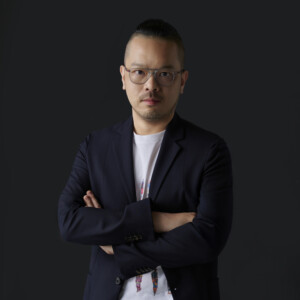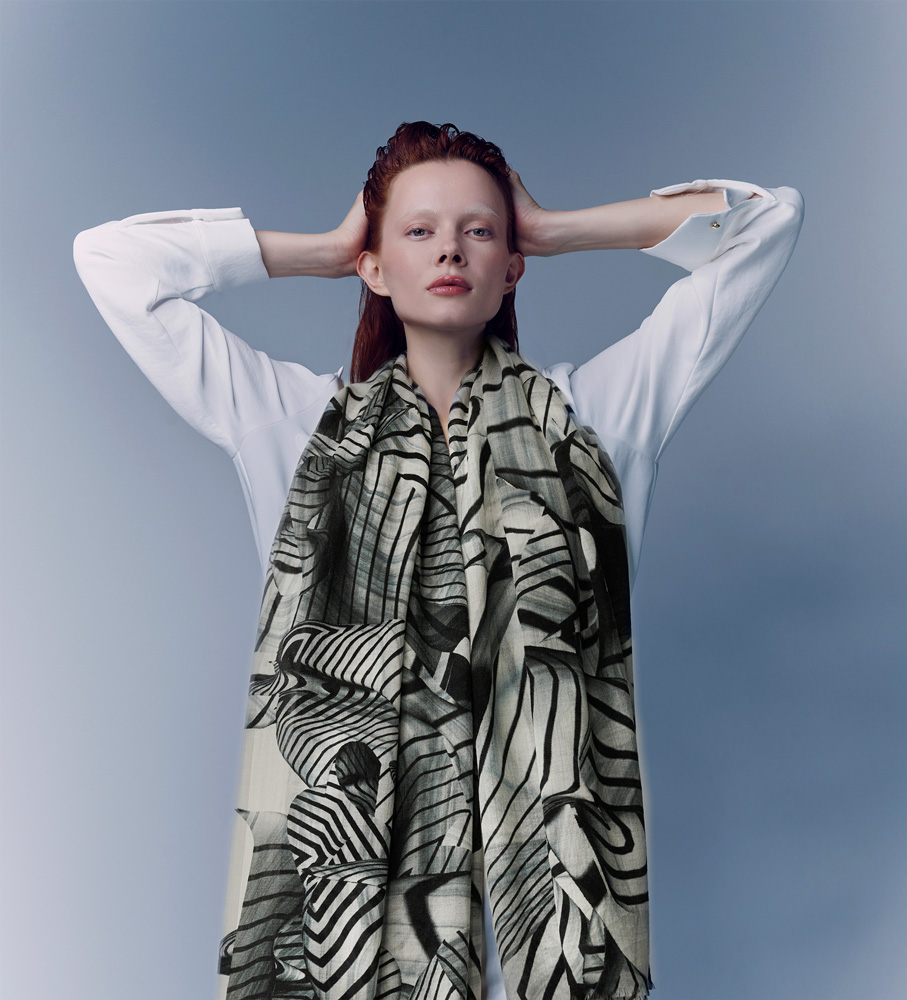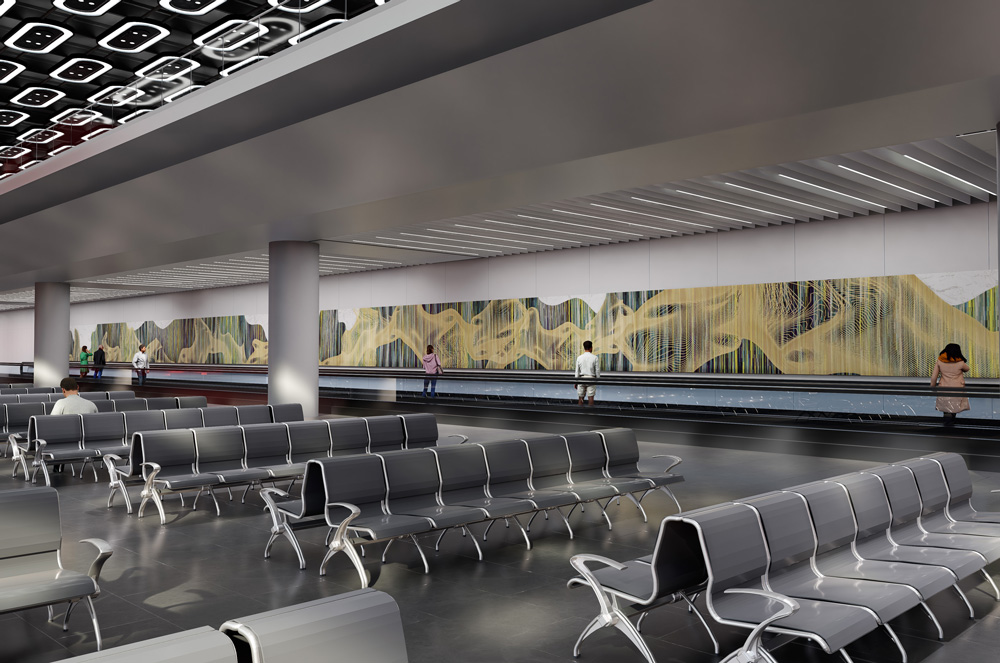
“Video installation, sculpture, ceramic, printmaking, textile—our work spans various media,” explains Yen-Ting Cho (MDes ’09) of his design studio’s creations, which range from luxury scarves to vast public artworks, the most recent for the new Terminal 3 in Taiwan’s Taoyuan International Airport. Despite the diversity in type and scale, these projects all derive from a singular underlying notion: human-computer interaction. “I always focus on combining human and computer-based thoughts,” says Cho. “For me, it’s a dialogue between the two, not an either-or question.” Cho’s blurring of boundaries integrates techniques from architecture, computer science, and other fields, exemplifying the transdisciplinary outlook he developed during his time at the Harvard Graduate School of Design (GSD).
From a young age, Cho cultivated multiple disciplinary interests. He naturally embraced technology and engineering, having been raised near Taiwan’s Hsinchu Science Park (an environment akin to California’s Silicon Valley). Simultaneously, Cho gravitated toward artistic creation; encouraged by his family and high school curriculum, he explored sketching, painting, traditional paper cutting, and calligraphy, as well as package design and music. Cho then studied architecture at National Cheng Kung University (NCKU), becoming well versed in analog and digital design tools while earning his bachelor of science degree (completed in 2005) and interning with architectural firms. “By this point,” he recalls, “I wanted to explore additional types of media, which I hoped could be more expressive and engage with a wider audience.” Thus, after completing his mandatory military service, in 2007 Cho entered the GSD’s Master of Design (MDes) program focusing on design and technology, eager to delve into alternative methods of creation.

“Crossing traditional disciplinary boundaries is never easy,” Cho declares. “Most training prepares students to fit into the so-called real world, which does not tend to favor disruption.” Fortunately, Cho found that the MDes program challenged this trend by encouraging multidisciplinary exploration. During his two years at the GSD, he took advantage of Gund Hall’s rich offerings as well as those at the Harvard Graduate School of Arts and Sciences and the neighboring Massachusetts Institute of Technology (MIT). Cho began by learning parametric design and computer programming, and then moved on to human-computer interaction courses at both the GSD and the MIT Media Lab. Within Harvard’s Department of Visual and Environmental Studies (now known as the Department of Arts, Film, and Visual Studies), Cho received fellowships to explore animation. He took photography courses, built his first robot, worked on an interactive installation for the Frank Lloyd Wright: From Within Outward exhibition (2009) at the Guggenheim Museum in New York City, and won several international awards for his experimental films.
In retrospect, Cho characterizes his time as an MDes student as truly formative. He found “Sculpting in Motion,” a course taught by then associate professor of practice Allen Sayegh, to be particularly impactful. “The tools used in the course were similar to those used for architectural design, but for different artistic expressions. I started to see the grey areas between design and art,” Cho says. By graduation, Cho had expanded his “interests from spatial design to temporal creation and had started to seriously think about, and tentatively build, creative digital tools.”
Inspired by Sayegh’s mentorship as well as a course at the MIT Media Lab called “New Paradigms for Human-Computer Interaction” (taught by Hiroshi Ishii), Cho decided to explore creations arising from human-computer interaction. Following his graduation from the GSD, Cho enrolled in London’s Royal College of Art (RCA) to pursue a PhD in Innovation Design Engineering. This program foregrounded practice-based research, and a diverse group of advisors—a cybernetician/design theorist, a film theorist, and an aeronautical engineer/design—helped Cho integrate his assorted interests.[1]

While a doctoral student, Cho collaborated with two Taiwanese researchers to develop mov.i.see, a digital software that “uses body movement to reconstruct inputted digital data.” This software would become integral for Cho; after completing his PhD in 2009, he started YEN TING CHO, a studio that uses mov.i.see to generate unique patterns, initially for textiles. Cho also began teaching at the Institute of Creative Design at NCKU, where he is now a professor.
With offices in London and Taipei, YEN TING CHO now describes itself as a digital design studio and consultancy that produces unique artworks, public installations, and contemporary designs for fashion accessories, interiors, and exteriors. Their creations feature colorful patterns that arise from running images through mov.i.see. The resulting designs are finished by hand, playing with color, space, and form, and are ultimately digitally printed onto a given surface, such as textiles or ceramics. With his studio, Cho intentionally fosters “an open and dynamic environment for creatives interested in transdisciplinary and practice-based research.” This breadth and experimentation allow the studio to tackle projects in a unique way, as is the case for its current focus: Gateway to Taiwan: Island Tales, a public installation for the north hall of the Richard Rogers–designed Terminal 3 at Taoyuan International Airport.

Cho fashioned Gateway to highlight aspects of Taiwan beyond its technological renown. To comprise the installation, he created seven artworks, each representing a different theme within Taiwanese history and culture—for example, spiritual life, the natural world, or the cityscape. The works, which collectively total over 300 meters, “show Taiwan’s creativity, interweaving technology and culture,” Cho explains. This interweaving plays out in both the process and products of creation. Following a phase of in-depth research, Cho manipulates his human reflections with his software to generate the semi-abstract thematic patterns. The abstraction encourages travelers of all cultures—visitors and locals—to engage with the works, to develop their own interpretations of Gateway and the island of Taiwan.
When Gateway opens in late 2025, the project will showcase the potential inherent in transdisciplinarity, which Cho initially encountered during his time as an MDes student at the GSD. “Perhaps that’s the beauty of the MDes program,” Cho says. “It’s not just architecture. It’s not just landscape. It’s not just urban design. It’s everything everywhere.”
[1] Aligning with these specialties, Ranulph Glanville, Al Rees, and Neil Barron were Cho’s advisors at RCA.